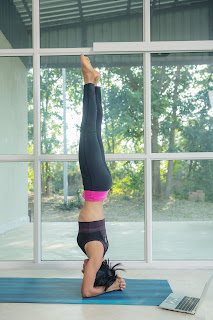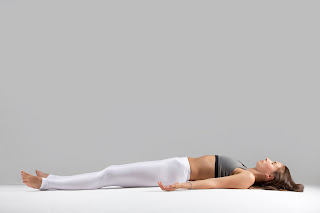Sirsasana- The king of all asanas
Sirsasana
In Sanskrit 'Sirsa' means head. In sirsasana, practitioners stand on their heads, thus the name sirsasana. This yoga asana is regarded as the king of all asanas and by the time you finish reading this article, you will find out why?
How to do Sirsasana?
- Spread a fourfold blanket and kneel near it.
- Rest the forearms on the blanket. the practitioner should take care that the upper arms are parallel to each other.
- Now, interlock the fingers tightly and rest the crown of the head between the palms.
- Raise the knees from the floor and walk towards the trunk with bent knees.
- With an exhalation, raise one leg off the ground first and balance. Now, raise the other leg from the floor. As you advance in practice, you will be able to raise both legs off the floor together without even bending your knees.
- Slowly straighten the thighs and then the knees.
- Stretch the legs fully and stand on the head while keeping the whole body in a straight line perpendicular to the ground.
- Stay in this pose for 30 seconds in the beginning and increase the time by a few seconds every day as per your capacity. Increase your capacity to at least 10 minutes by practicing regularly. Many yoga masters do this pose for many hours continuously.
- There are advanced versions of this asana also which can be learned once this primary pose is mastered.
Precautions while doing Sirsasana
- Beginners must practice this asana near the wall.
- Use the arms as a support tool only. Maximum weight should be on the head.
- Do not stand up immediately after coming out of sirsasana.
- At the start head may feel heavy after doing this yoga pose but with the correct technique heaviness will go away.
- Do not rush into the asana, take your time. Perfection will come only with time and practice.
- Breathing should be done with the nose only not the mouth. In starting breathing will be heavy but with time it will become finer and finer.
- This asana should not be performed for very long durations during summer but in winter it can be done for any length of time.
- If sirsasana is done for longer periods, strengthening and juicy foods such as milk and juices should be consumed after doing this asana.
Contraindications of sirsasana
People with high blood pressure, heart palpitations, thrombosis, vertigo, chronic cataract, severe nearsightedness, very impure blood, and chronic constipation should not attempt this asana without medical guidance. Old people with fragile muscles and bones should not attempt this asana.
Benefits of sirsasana
- It increases the blood flow to the brain and helps in improving memory and concentration.
- It helps in the rectification of many nervous and glandular disorders.
- Due to the opposite flow of blood, it aids tissue rebuilding.
- It helps in removing headaches, psychological issues, and lack of energy.
- Sirsasana helps in the treatment of diseases related to the reproductive system.
- Due to the increased blood flow towards the head, it nourishes eyes, and ears, and helps in the growth of hairs.
- It helps in correcting the nightfall and helps in keeping up brahmacharya.
- It improves nervous coordination and increases core strength.
- It improves appetite and the functioning of all abdominal organs.
- This asana reduces weight very quickly due to increased appetite.
Note: Sirsasana should always be practiced with Sarvangasana as it prevents the agitation of the mind due to increased energy levels by calming the nervous system.
This asana is one of the most superior asanas for the physical, mental, and emotional well-being of humans. Hence this yoga pose should be practiced by all regularly.
Attributions:
<a href="https://www.freepik.com/free-photo/sporty-woman-practicing-yoga-doing-headstand-exercise-salamba-sirsasana-pose-working-out-wearing-sportswear-black-watching-fitness-video-tutorial-online-laptop-doing-workout-home-sitting_14779507.htm#query=sirsasana&position=0&from_view=search&track=sph">Image by jcomp</a> on Freepik



Comments
Post a Comment